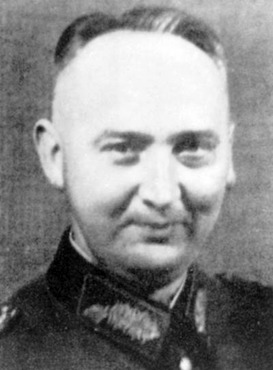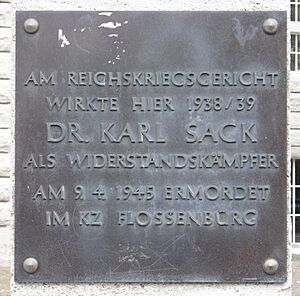Karl Sack facts for kids
Karl Sack (born June 9, 1896 – died April 9, 1945) was a German lawyer and judge. He was also an important member of a secret group that resisted the Nazi government during World War II.
Contents
Karl Sack's Early Life and Work
Karl Sack was born in a place called Bosenheim, which is now part of Bad Kreuznach. He went to college in Heidelberg to study law. After finishing his studies, he became a judge in a German state called Hesse. He was married to Wilhelmine Weber and they had two sons.
In 1934, Karl Sack joined a new court called the Reich Military Court. This court dealt with legal cases for the German military. He quickly became a very important person there.
Sack used his position to help people. For example, he managed to slow down a case against a high-ranking army leader named Werner von Fritsch. This leader had been wrongly accused of a crime by the Gestapo, which was the Nazi secret police. They wanted to make him look bad because he disagreed with Hitler's plans to control the army.
In late 1942, Karl Sack became the chief military judge for the army. This was a very powerful role.
Joining the Resistance Movement
During World War II, Karl Sack secretly worked with groups that were trying to stop Hitler and the Nazis. He had connections with many brave people in the military, including Admiral Wilhelm Canaris and Major General Hans Oster. He also worked with others in the Abwehr, which was Germany's military intelligence service.
Karl Sack was part of a very important plan to assassinate Hitler. This plan is known as the 20 July plot. The goal was to kill Hitler and then take over the government to end the war.
Arrest and Execution
Sadly, the plan to assassinate Hitler failed. Karl Sack was arrested on August 9, 1944, because of his involvement.
In the very last days of the war, he was brought before a special, quick military court run by the SS. This court was not fair. He was sentenced to death and was hanged just two days later at Flossenbürg concentration camp.
If the plot had succeeded, Karl Sack was supposed to become the Justice Minister in the new government. This shows how important he was to the resistance movement.
Remembering Karl Sack
In 1984, Karl Sack's brave actions as a resistance member were honored. A bronze plaque was placed at the old Reich Military Court building in Berlin-Charlottenburg.
There was some discussion about this honor. Some people worried because Sack had strong views on what counted as desertion (leaving the army without permission). These views could have led to harsh punishments for soldiers.
However, his overall role in fighting against the Nazi regime was recognized. Today, a street in Bosenheim, where he was born, is named in his honor.
See also
- List of members of the 20 July plot



